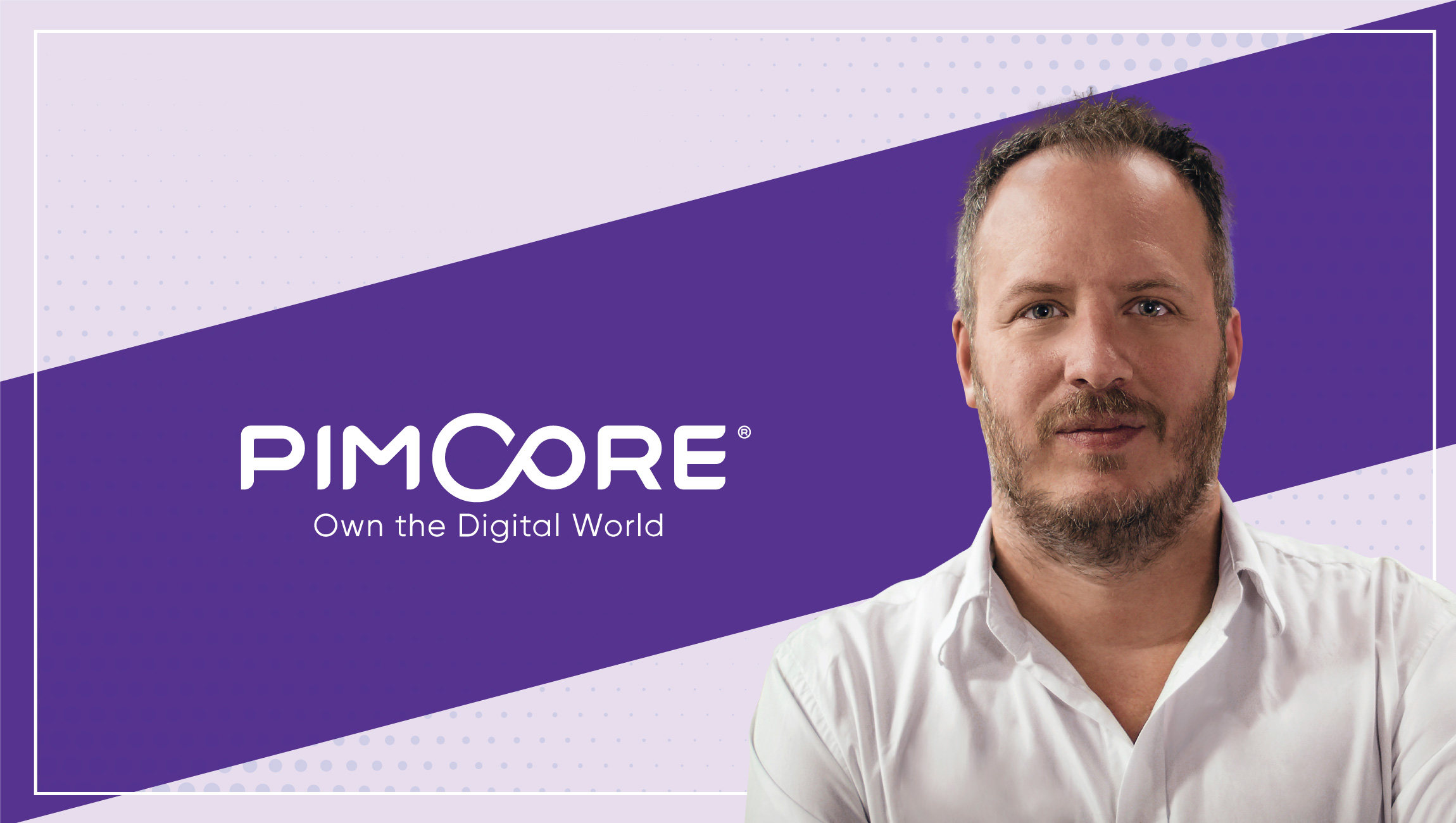Tell us about your role and journey into technology. How did you arrive at Pimcore?
Pimcore was carved out of a digital agency named New Elements Media Solutions in Salzburg, Austria, in 2010, where I (along with the other co-founders of Pimcore) spent close to seven years. Pimcore was formed out of a strong desire to change the way we were functioning. All of our projects were turning into data management nightmares, as we were using multiple softwares for multiple tasks, and required multiple interfaces. There were severe troubles with updating and syncing several programming languages. And all of it was being done for every single customer. Even the smallest of updates in any of the systems were pushing our projects to the brink of breaking up. Our developers were working under tremendous pressure. Besides, the quality we were delivering to our clients was suffering, along with our time-to-market.
Pimcore came about as we attempted to find a solution that could manage any amount and type of data, be used across industries, and was agile enough to adjust to rapidly changing customer and business demands. We realized the potential of open-source as a means to organize and streamline product data across enterprises and improve their customer experience. For the past nine years, we have been working with customers across the retail, CPG, manufacturing, automotive and healthcare industries to show just how easy data management for an organization can be.
From the time you joined Pimcore, how much has marketing technology for retail and ecommerce landscapes evolved?
Since we founded Pimcore in 2010, the retail and eCommerce landscapes have evolved dramatically. Customer experience has taken the industry by storm; it’s at the core of almost every enterprise decision. While price used to be what determined where consumers would direct their wallet share, it’s now based on where they’re going to have the most convenient, streamlined and unique experiences across channels. Retailers are realizing that it’s no longer enough to provide one message or one discount to every customer. Each customer demands an experience that’s tailored to their specific needs and preferences, and retailers that fail to provide this will lose an entire subset of customers.
In the last 10 years, marketers have shifted their focus to technology, in an effort to provide these unique experiences across channels – whether that be online, in-store, on their mobile phones, even through voice devices. And as they’ve realized the necessity to provide personalized experiences across channels, marketers are investing in the solutions to appropriately and accurately, gather and store product data, and then use that data to create consistent experiences across platforms. I believe we’ll continue to see a rise in open-source and Cloud solutions over the next 10 years, as marketers increasingly understand the importance of strong master data management strategies to obtain customer insights that drive differentiated experiences.
As a Marketing Technology CEO, how would you identify the biggest advantages and challenges of leading a data-driven company?
The biggest advantage is that as an open-source enterprise software, which is 100% API driven, we’re in a unique position to handle projects of any scale and scope for any industry. We can help enterprises by simplifying their IT architectures, decreasing their time-to-market and enabling an awesome ROI. We’re very proud to offer Pimcore for free to enterprises around the world through an open-source licensing model.
As for challenges, I’d say that being a technology product, we have to constantly be on a path of evolution and invention. There are new features being added to Pimcore night and day. So, that keeps you on your toes all the time. Second, I’d say every use case is a challenge, as it comes with its own requirements and expectations. Many clients come to Pimcore, after having tried other similar platforms, many that are our competitors. So, gaining their trust and then retaining it, I’d say is another big challenge.
What valuable lessons did you learn from 2018’s massive mergers and acquisitions in the Ecommerce and Data Management areas?
In the B2B technology sector, 2018 was a big year for acquisitions, and the deals we saw in commerce and customer experience were unparalleled. Adobe’s acquisitions of Magento and Marketo, and SAP’s purchase of Qualtrics show just how important digital commerce and customer experience data are across industries, as these two historically tech-focused companies invested in eCommerce solutions for enterprises. It’s a unique merger as Adobe, which is a proprietary software, acquired Magento, which is open source. This signals a huge paradigm shift in the way the world views open source. On the other hand, customers expect a seamless experience working with different products from a single vendor. And seamlessly bringing together Magento and the existing marketing suite from Adobe might be a challenge.
One of the biggest learnings is that buyers demand convenience, and B2B players need to invest in the solutions that deliver, and allow buyers to make purchases across touchpoints, provide personalized offers and mirror their consumer shopping experiences. Second, data provides additional insight into buyer preferences, as B2B organizations can now collect these insights across more touchpoints than ever before. Having strong data on hand is crucial for business and customer experience strategy, and can point to future acquisitions that might be necessary in order to retain customers.
There was also a big focus on data management this year, specifically with Salesforce’s acquisition of Mulesoft. This indicates that organizations are serious about increasing the agility and flexibility of their data outside of legacy systems and use it to drive both business operations and customer experience. Enterprises are realizing that they must have the data management solutions in place to compete at the speed that their customers demand today, and are investing in the tools that allow them to pivot quickly.
We’re seeing that software vendors are starting to think in platforms, rather than in best-of-breed applications. Therefore, the trend we started in 2009 by bringing together data and experience management into one single and seamless interface is now imitated by all the global vendors, such as Salesforce, SAP and Adobe. And platforming is the exact right move for creating successful data-driven digital experiences to put the customer at the center of everything.
Tell us about your go-to strategies to support rapid growth, lessons learned through periods of massive shift and transition.
Growth is always a challenge, especially for startups with an open-source business model. Particularly, the biggest challenge we faced was growth in three different continents, all with different time zones and cultures factored into the mix, while scaling massively from five employees to more than 120. In the beginning, our resources were always limited and we were just figuring out our structures, processes, teams and budgets. While it was tough to adapt to these changes early on, it was important to realize that change is constant, and communication across our teams and offices would be crucial for our success.
Leading with the mentality that change is inevitable has been a strategy that’s enabled great success, such as being named a Gartner Cool Vendor, expanding our product and services to the U.S. and experiencing a $3.5 million Series A investment at the end of last year. We view change as innovation, and it’s helped us evolve our solution and the way that our customers conduct business today, providing them with the flexibility and agility to transform customer experience in the digital age.
How do you mentor your product marketing and B2B commerce teams at Pimcore?
Our product marketing and B2B commerce teams are an empowered lot already. Our love for open-source technology is a binding factor. We make it a point that the teams stay agile and collaborative at every stage. Everyone lends an ear to everyone else. Every suggestion is welcome. We continually hold several joint sessions across all three continents to ensure that everyone stays on the same page and feels they’re a significant part of Pimcore.
What does your technology community look like? Who do you meet at events and conferences to discuss technology?
Honestly, as we currently scale up our operations, build exciting new products and awesome services such as subscriptions and PaaS, there is almost no time to attend events and conferences. That’s of course a pity and I’m quite sure that will change in the future again. So my interaction with the tech community is currently rather virtual via social media. I even got addicted to LinkedIn lately.
Which Marketing and Sales Automation tools and technologies do you currently use?
That’s an easy one to answer. We use Pimcore for that. The Pimcore Experience Cloud – a functionality that is also available open-source and free of charge – is the ideal framework for creating sophisticated marketing and sales automation tools on top of our open source customer data platform (CDP). Even our CRM is on top of Pimcore. And I think that’s even better then Salesforce, I might add.
What are your predictions on the most impactful disruptions in Marketing and Sales technology for 2019-2020?
Over the next year, I believe we’ll see a rise in the use of open-source software as a means to manage product data and experience. With more and more departments across organizations (IT, sales, marketing, etc.) impacting customer experience, it’s crucial that companies have a solution that allows them to aggregate valuable product data from every touchpoint and use it to drive and create personalized offerings for each customer.
The flexibility of open-source software allows organizations to evolve their strategies quickly, as customer demands change at the drop of a hat. These solutions are more cost-efficient and agile compared to legacy systems like SAP, and allow for secure storage and sharing of product data across departments. Plus, the total cost of ownership is far less than other solutions, and allows the IT department more freedom to make changes with either a small licensing fee or none at all. I think this is the future of CX technology, especially with the ever-increasing demand for personalized experiences.
What startups in the technology industry are you watching keenly right now?
There are a few hidden champions in the field of data and experience management that we monitor and watch closely. But I won’t tell any names, because after our next round of investment these hopefully will get bought.
How do you prepare for an AI-centric world as a business leader?
Preparing for an AI-centric world involves getting your data in line, organized and clean so that the technology can function best. Global organizations know that AI’s strengths are streamlining and analyzing massive data sets, so in order to use the technology to its fullest potential, it’s crucial that business leaders prioritize master data management. This can involve investments in open-source and Cloud solutions to ensure that all data from across the organization is in order so AI can get to work, collect customer insights and analyze that data to drive next-level business processes and strategy.
In addition, ensuring that product information is accurate and well developed is crucial for organizations to operate in an AI-centric world. This way, smart technology like AI and machine learning tools can effectively learn and provide insights on where content can be improved across channels to enhance customer experience. It’s important that businesses prepare themselves so that AI can operate efficiently, especially as this technology becomes a more central aspect of organizational strategy.
How do you inspire your people to work with technology?
Technology is the foundation of our work. No inspiration needed. Pimcore people love tech.
One word that best describes how you work.
Currently “Better done than perfect.” Because I work 50% at Pimcore and still 50% at the digital agency. In the years to come: “Think different.”
What apps/software/tools can’t you live without?
Chrome, Outlook, Powerpoint – and Pimcore. I’m pretty mainstream.
What’s your smartest work related shortcut or productivity hack?
Red Bull, especially as it’s made in my hometown.
What are you currently reading? (What do you read, and how do you consume information?)
The Hard Thing About Hard Things by Ben Horowitz
What’s the best advice you’ve ever received?
Get your own kids as early as possible.
Something you do better than others – the secret of your success?
Connecting people and ideas.
Tag the one person (or more) in the industry whose answers to these questions you would love to read:
SAP’s Bill McDermott. Pimcore should take over SAP by the way.
Thank you, Dietmar! That was fun and hope to see you back on MarTech Series soon.
As CEO and co-founder of Pimcore and as manager of digital agency Elements, Dietmar Rietsch deals with new technologies and the digital transformation of companies daily. Dietmar is a passionate entrepreneur who has been designing and realizing exciting digital projects for more than 20 years.
The MTS Martech Interview Series is a fun Q&A style chat which we really enjoy doing with martech leaders. With inspiration from Lifehacker’s How I work interviews, the MarTech Series Interviews follows a two part format On Marketing Technology, and This Is How I Work. The format was chosen because when we decided to start an interview series with the biggest and brightest minds in martech – we wanted to get insight into two areas … one – their ideas on marketing tech and two – insights into the philosophy and methods that make these leaders tick.






.png)





